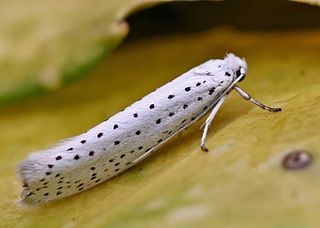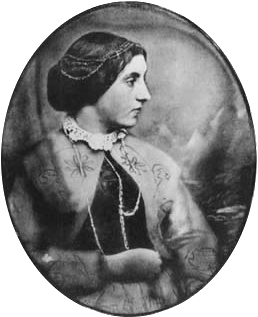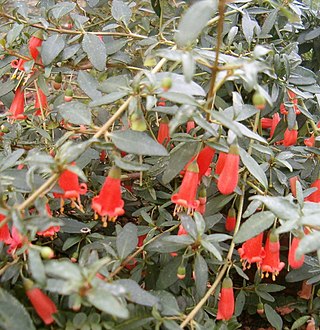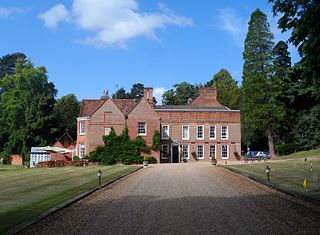
The family Yponomeutidae are known as the ermine moths, with several hundred species, most of them in the tropics. The larvae tend to form communal webs, and some are minor pests in agriculture, forestry, and horticulture. Adult moths are minor pollinators.

John Lindley FRS was an English botanist, gardener and orchidologist.

John Claudius Loudon was a Scottish botanist, garden designer and author. He was the first to use the term arboretum in writing to refer to a garden of plants, especially trees, collected for the purpose of scientific study. He was married to Jane Webb, a fellow horticulturalist, and author of science-fiction, fantasy, horror, and gothic stories.

Yponomeutoidea is a superfamily of ermine moths and relatives. There are about 1,800 species of Yponomeutoids worldwide, most of them known to come from temperate regions. This superfamily is one of the earliest groups to evolve external feeding and to colonize herbs in addition to shrubs and trees.

The Wych Elm cultivar Ulmus glabra 'Lutescens', commonly known as the Golden Wych Elm, arose as a sort of a wych found in the York area in the early 19th century by W. Pontey of Pontey's nursery, Kirkheaton, Huddersfield, who propagated and distributed it. The original tree he named the Gallows Elm for its proximity to a gallows near York. Loudon in The Gardener's Magazine (1839) identified it as a form of Ulmus montana, adding 'Lutescens' by analogy with Corstorphine sycamore, Acer pseudoplatanus 'Lutescens'.
The elm cultivar Ulmus 'Ramulosa' [: 'twiggy'], Floetbeck elm, was raised in the Floetbeck nurseries, Hamburg, by James Booth & Son, and was first mentioned by Loudon in Arboretum et Fruticetum Britannicum (1838) as Ulmus montana glabra var. ramulosaBooth, but without description. It does not, however, appear in Booth's 1838 list. Loudon listed the tree in a group including Downton Elm, Scampston Elm, and Ludlow Elm, so Green's wych cultivar attribution appears to be an error.

Jane Wells Webb Loudon was an English author and early pioneer of science fiction. She wrote before the term was coined, and was discussed for a century as a writer of Gothic fiction, fantasy or horror. She also created the first popular gardening manuals, as opposed to specialist horticultural works, reframing the art of gardening as fit for young women. She was married to the well-known horticulturalist John Claudius Loudon, and they wrote some books together, as well as her own very successful series.
Argyresthia arceuthina is a moth of the family Yponomeutidae. It is found in Europe.

Thomas Allason (1790–1852) was an English architect, surveyor and landscaper, noted in particular for his work at Connaught Square and the Ladbroke Estate in Kensington.
William Speechly was a late 18th- and early 19th-century English horticulturist, best known as the head gardener to William Henry Cavendish-Bentinck, 3rd Duke of Portland, and for his skill in growing pineapples and grapes.

The Clapton Nursery also known as Mackay's Clapton Nursery and later Low's Clapton Nursery was a plant nursery established in the early 19th century by John Bain Mackay in Upper Clapton, London, and noted for its introductions of Australian and South American plants into cultivation.

Flitwick Manor is a Georgian country house in the south of Flitwick, Bedfordshire, England. It is located on Church Road off the A5120 road. Now operating as a hotel, the manor is a Grade II* listed building. Now owned by Flitwick Town Council, much of the Grade II Register of Historic Parks and Gardens listed park is accessible to the public.

Histon Road Cemetery, formerly Cambridge General Cemetery, is a cemetery in north Cambridge, England, lying off Histon Road, opened in 1842. It is notable as one of only three designs by John Claudius Loudon, who covers it in detail in his influential book On the Laying Out, Planting and Managing of Cemeteries (1843); the other cemeteries associated with Loudon are Bath Abbey Cemetery, and Southampton Old Cemetery. These experiences of practical planning directly affected Loudon's writing on the subject.
Charles Hampden Turner (1772–1856) was a British businessman, now known as a collector and gardener.

John Donaldson (1799–1876) was Scottish agriculturalist, professor of Botany at the Royal Agricultural Training School, Hoddesdon, government land drainage surveyor, and author of prize essays works, best known as author of the 1854 Agricultural Biography.
James Anderson was a Scottish botanical collector who later became the superintendent of the Sydney Botanic Gardens.
The Metropolitan Sepulchre was a massive pyramidal necropolis proposed for construction in Primrose Hill in London in the 19th century as a way of addressing the shortage of burial space in the London area. Designed by the architect Thomas Willson, it would have been 90 stories high, and capable of holding up to five million dead. The 18-acre footprint of the pyramid would have allowed a number of burials equal to 1000 acre of regular cemetery ground. Willson said that "Not many centuries will pass away before it will not only be completely filled, but that another one will be required."

Daniel Ellis FRSE (1771–1841) was an English physician, aerologist, botanist and author. He spent most of his career in Scotland and was an important contributor to Edinburgh’s Encyclopædia Britannica. He was president of the Royal Medical Society in 1806.

Dumelow's Seedling is a cultivar of domesticated apple that originated at Shackerstone in Leicestershire where it was grown by Richard Dumeller in 1800. It is known by many other names including 'Dumelow's Crab', 'Wellington', 'Doncklaer', 'Beauty', and 'Belle de Vennes'. The fruit is not ready for harvest until October, being one of the last of the season, and keeps well into the next year. Though inferior for use as a dessert apple it cooks well and in early-20th century England was one of the most valuable varieties of cooking apple.

William Pamplin was an English bookseller, publisher and botanist. Hunneman introduced many non-native European plants to the United Kingdom.














